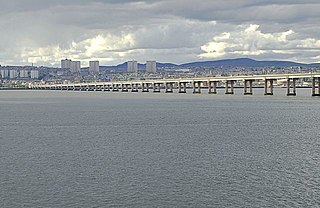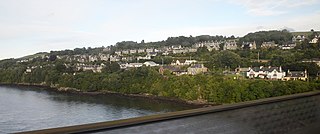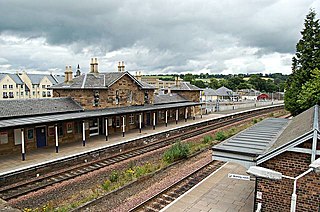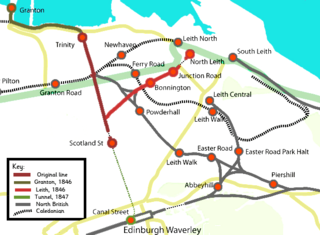This article needs additional citations for verification .(January 2008) |

Newport-on-Tay East railway station formerly served the town of Newport-on-Tay, Fife, Scotland. The station closed in 1969.
This article needs additional citations for verification .(January 2008) |

Newport-on-Tay East railway station formerly served the town of Newport-on-Tay, Fife, Scotland. The station closed in 1969.
Newport-on-Tay East station was opened by North British Railway on 13 May 1879 [1] with a branch line from the southern end of the Tay Bridge which was later extended to Tayport. In 1923 it became the LNER and from 1948 the Scottish Region of British Railways. The line was single track but with passing places at Wormit station and the second was at Newport-on-Tay East. The single platform Newport-on-Tay West railway station was much smaller.
The East station had two platforms which were curved slightly to follow the line of the track. At the end nearest Station Road there was a level crossing and a pedestrian bridge. The main ticket office, and the stationmaster's house were situated on the up track (towards Tayport). On the down track, there was only a waiting room. The station was lit by gas lamps, which were activated by the station staff. The signal box was situated at the far end of the Eastbound platform, and the signalmen used to hand the pouches containing the tokens for the stretch of track to Tayport from a platform situated on the stair leading up to the signal box.
The strip of land between the up track and Norwood Terrace contained allotments. The land on the other side of the main tracks was taken up by a goods yard. Two coal merchants had their premises here. There was also an additional spur of track leading to a ramp which was used for loading sugar beet. At harvest time, tractors loaded with beet would drive in and tip the contents of their trailers into railway waggons parked on this spur.
The station layout shown on the 1914 Ordnance Survey map remained practically unchanged till it closed.
There were two accidents in the station. In one case, a train hit one of the level crossing gates, and it had to be replaced. The other accident was more serious. A workman was killed during an accident while shunting coal waggons.
The railway was mainly used by people who lived in Newport and worked in Dundee. Until the opening of the Tay Road Bridge in 1966 the Tay Ferry provided the only alternative means of getting there. The opening of the Road Bridge allowed direct bus services from Newport to Dundee, as well as easy access by car, thus directly leading to the closure of the line in 1969.

During the 1960s the trains were normally pulled by British Railways 2-6-4T engines. Later the steam trains were replaced by diesel multiple units, probably British Rail Class 101.

The Tay Road Bridge carries the A92 road across the Firth of Tay from Newport-on-Tay in Fife to Dundee in Scotland, just downstream of the Tay Rail Bridge. At around 2,250 metres (1.4 mi), it is one of the longest road bridges in Europe, and was opened in 1966, replacing the old Tay ferry.

Newport-on-Tay is a small town in the north-east of Fife in Scotland, acting as a commuter suburb for Dundee. The Fife Coastal Path passes through Newport-on-Tay. The area itself is surrounded by views of the two bridges that cross the River Tay and distant views of the Scottish Highlands.

Wormit is a village on the south shore of the Firth of Tay in north-east Fife, Scotland. Its location at the southern end of the Tay Rail Bridge has led to it becoming a commuter suburb of Dundee. Together with Woodhaven and Newport-on-Tay, Wormit is a part of The Burgh of Newport-on-Tay. The name of the village is thought to be derived from the plant wormwood.

Severn Tunnel Junction railway station is a minor station on the western side of the Severn Tunnel in the village of Rogiet, Monmouthshire, Wales. It is 123.5 miles (198.8 km) from London Paddington and lies at the junction of the South Wales Main Line from London and the Gloucester to Newport Line.

Dundee railway station serves the city of Dundee on the east coast of Scotland. The station has two through platforms and two terminal platforms. It is situated on the northern, non-electrified section of the East Coast Main Line, 59+1⁄4 miles (95.4 km) northeast of Edinburgh. Dundee is the tenth busiest station in Scotland. In January 2014, the former main station building was demolished to make way for a new building as part of the Dundee Waterfront Project which opened on 9 July 2018.

Kirkcaldy railway station is a railway station in the town of Kirkcaldy, Fife, Scotland. The station is managed by Abellio ScotRail and is on the Fife Circle Line and principal East Coast Main Line, 26 miles (42 km) north east of Edinburgh Waverley. British Transport Police maintain a small office on Platform 1.

Leuchars railway station serves the towns of Leuchars and St Andrews in Fife, Scotland. The station is the last northbound stop before Dundee.

Cupar railway station is a railway station that serves the town of Cupar in Fife, Scotland. The station has two platforms, of which the southbound one is now wheelchair accessible. Services are provided by Abellio ScotRail and CrossCountry.
The Dundee and Arbroath Railway was an early railway in Scotland. It opened in 1838, and used the unusual track gauge of 5 ft 6 in (1,676 mm). In 1848 it changed to standard gauge and connected to the emerging Scottish railway network.
The Dundee and Perth Railway was a Scottish railway company. It opened its line in 1847 from Dundee to a temporary station at Barnhill and extended to Perth station in 1849. It hoped to link with other railways to reach Aberdeen and changed its name to the Dundee and Perth and Aberdeen Railway Junction Company, but this early attempt was frustrated, and for some years it failed to make a physical connection with other railways in Dundee.
The Edinburgh and Northern Railway was a railway company authorised in 1845 to connect Edinburgh to both Perth and Dundee. It relied on ferry crossings of the Firth of Forth and the Firth of Tay, but despite those disadvantages it proved extremely successful. It took over a short railway on the southern shore of the Forth giving a direct connection to Edinburgh, and it changed its name to the Edinburgh, Perth and Dundee Railway.

The Edinburgh, Leith and Newhaven Railway was a railway company formed in 1836 to connect the city of Edinburgh with the harbours on the Firth of Forth. When the line connected to Granton, the company name was changed to the Edinburgh, Leith and Granton Railway. It opened part of its route in 1846, but reaching the centre of Edinburgh involved the difficult construction of a long tunnel; this was opened in 1847. It was on a steep incline and was worked by rope haulage.
The Newburgh and North Fife Railway was a Scottish railway company formed to build a connecting line between St Fort and Newburgh, in Fife, intended to open up residential traffic between the intermediate communities and Dundee and Perth. It opened its line, which was expensive to construct, in 1909 but the local traffic never developed. It closed to passenger traffic in 1951, and completely in 1964.
The St Andrews Railway was an independent railway company, founded in 1851 to build a railway branch line from the university town of St Andrews, in Fife, Scotland, to the nearby main line railway. It opened in 1852. When the Tay Rail Bridge opened in 1878 residential travel to Dundee was encouraged.
The Newport Railway was a Scottish railway company, that built a line along the south bank of the Firth of Tay in Fife. The line was opened in 1879, and connected to the Tay Bridge, giving quick access to Dundee; daily residential travel to Dundee from Tayport became a practicality.
The Railways of Kinross were a local network of three rural railways which made the town of Kinross in Scotland their objective in the 1850s.
Several mineral railways were constructed around Dunfermline in western Fife, Scotland, in the eighteenth century and later. Their purpose was to convey minerals to market from the outcropping coal deposits that had encouraged industrial activity in the area from an early date.
The Forth Bridge approach railways were railway lines constructed in the period 1887 to 1890 to form new main lines on the opening of the Forth Bridge at the Queensferry crossing. Until then, only local branch lines approached the location. The North British Railway built new main lines and upgraded some existing lines.

Tayport railway station served the town of Tayport, Fife, Scotland from 1848 to 1967 on the Newport Railway.

Balmore railway station was opened in 1879 on the Kelvin Valley Railway and served the coal mining area, farms and the village of Balmore in East Dunbartonshire until 1951 for passengers and to freight on 31/7/61.